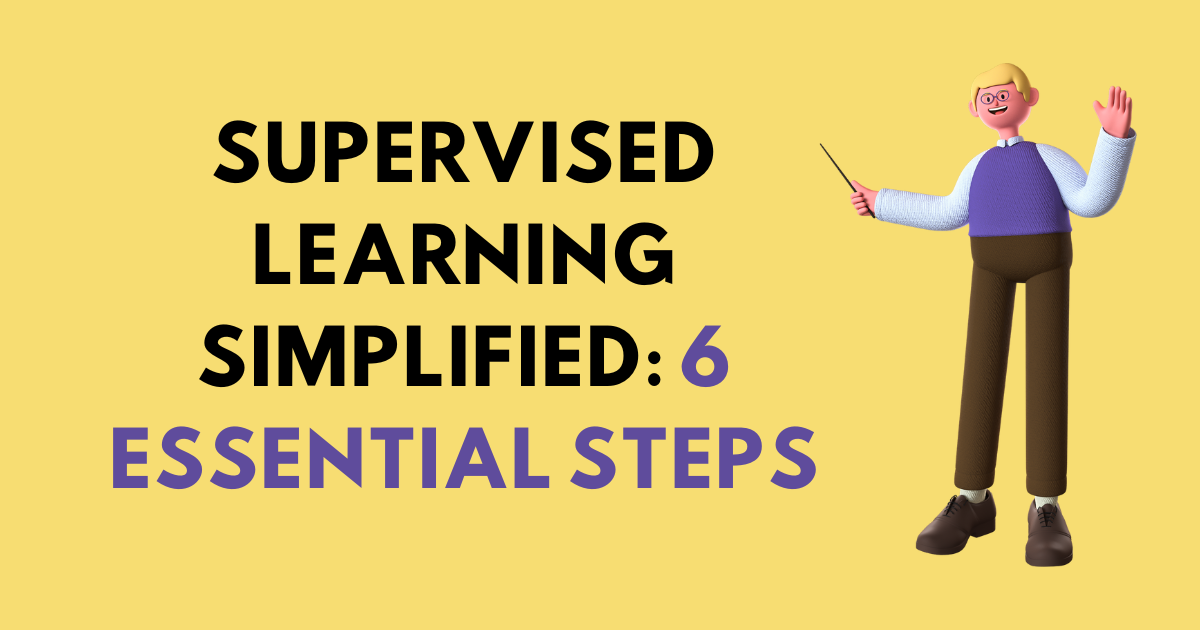6 Essential Steps to Building a Supervised Learning Model: A Beginner’s Guide
 S.S.S DHYUTHIDHAR
S.S.S DHYUTHIDHAR
Hey Guys! This is Dhyuthidhar, Welcome to my Blog. If you don’t know me...", you could say "Hi, I’m Dhyuthidhar, and if you're new here, welcome! I love writing about all things Computer Science, especially in the realm of Machine Learning. Here is your new interesting blog which talks about Supervised Learning.
This blog is all about building a supervised learning model. The big question is, does it really take just six steps? Or more? Let’s dive in and see how many steps we need to create a robust supervised learning model.
I think everyone knows what is supervised learning. If you're new to the concept of supervised learning, I recommend checking out my previous blog where I explain the types of Machine Learning models. That way, you'll have a solid foundation before diving into this guide."
I hope you will read that blog and learn about supervised model and come to this blog back again.
So, Let’s dive into the topic, Buckle Up Guys!!

Step 1 -: Gather the data.
We all know that machine learning doesn’t work without data. Will it?
I think if you have to build a mathematical distribution you need data. If you need to know more about it go to my previous blog, where I explained about how machine learns?
So we need data and it will be the first step, as we have a problem statement and if the problem statement domain is specifically on cricket we need to select the data based on that domain as well we need to be specific based on the problem statement.
And the most important thing, as we are creating a supervised learning model we need to get the data that have labels if we don’t have labels we won’t create a supervised learning model as it comes under unsupervised.
The label can be categorical or numerical data, which is the true output of the data. The input can be of any type of data.
For example spam detection, where we either take messages(text), or email (text) as input with the labels as either spam or not spam, which is categorical.
There are a lot of ways to gather the data, either you can get pre-defined data from websites like Kaggle or you can get the data from a data warehouse or you can use an API and get the required data or you can get web scraping using tools like BeautifulSoup etc.
Will I get the model just with data, nope. So, what next? Can I make the model directly as I got the data? Ok..Ok! lets go to next step.
Step 2 -: Converting the Data into a Feature Vector
So What is a Feature Vector?
It is the numerical representation of the data point in a multi-dimensional space.

Maybe you guys are thinking about what this guy is saying about multi-dimensional space looks like we are entering into the space world!! What in this world is Multi-dimensional space?
So dimensions are features and we represent features as dimensions in vector algebra.
Features -: {Age, Height, Weight} → Individual Info
So data point will consist of these features.
Vector = [Age, Height, Weight]
Here:
The first dimension represents Age.
The second dimension represents Height.
The third dimension represents Weight.
Multi-dimensional space simply means that your data has several features, like age, height, and weight, each of which represents a different dimension.
There are a lot of sub-steps in this step. Here are all
Pre-process the data -: Here we will clean the data and make it perfect for your problem statement by cleaning it using many steps including,
Handling Missing Values -: You need to handle the missing values in the data.
Normalization/Standardization -: Scale the numerical columns/features to ensure they are in the same scale.
Feature Extraction -: Identify and Extract the needed data for your specific problem from the dataset. Dependinf on the type of data, different methods are used.
Numerical data -: Directly use these values without making any changes.
Categorical data -: Here you need to convert this data into numerical data. There are many methods including,
One-Hot Encoding
Label Encoding
Text Data -: Convert word phases into numerical data using methods including
BOW (Bag Of Words)
TF-IDF (Term Frequency-Inverse Document Frequency)
Word Embeddings
Image Data -: Here we need to convert the data into pixels. Here are some methods,
Pixel Values.
CNN (Convolutional Neural Networks)
Constructing the Feature Vector: Combine the extracted features into a single vector for each data point. This vector will be used as input for machine learning models.
So I explained to you some steps, I will make a specific blog on this topic where I will explain to you in point to point way about this topic. Let’s go to the next step.
Step 3 -: Compute the Decision Function.
So we created the feature vectors, In supervised learning each feature vector is represented as,
$$\{ x_i \}_{i=1}^{N}$$
There is one more variable which is known as the weight vector that is used during the training process of the model. It represents the importance of each feature in making predictions.
It is represented as,
$$\{w\}$$
The decision function is the dot product of the weight vector as well as the feature vector. It is represented as,
$$f(x_i) = w \cdot x_i$$
Subtract the bias term from the formula.
$$f(x_i) = w \cdot x_i - b$$
Example: In logistic regression, f(x) is the linear combination of input features. In SVM, f(x) determines which side of the decision boundary a point lies.
- It is known as the prediction function in regression models.
The same form of the function is used:
$$f(x_i) = w \cdot x_i - b$$
- However, instead of defining a boundary between classes, this function directly predicts a continuous outcome, such as the price of a house.
Step 4 -: Train the Model (Optimize Parameters)
In some models like neural networks, activation functions (like ReLU, and sigmoid) help transform the output. In linear models, we adjust the weights to minimize prediction error (for regression) or improve class separation (for classification).
Classification Models: If f(x) >= 0, then the output will be +1; otherwise, it will be -1.
Regression Models -: We will take the average of all values.
To improve the performance we will adjust the values of w and b.
Classification Models: Adjust the decision function to maximize the separation between classes.
Regression Models: Optimize the function to minimize the error between predicted and actual values (e.g., using mean squared error).
Step 5 -: Evaluate the model
- Objective: Assess the model's performance on new data.
For Classification: Analyze metrics such as accuracy, F1 score, or ROC-AUC to determine how effectively the decision boundary distinguishes between classes.
For Regression: Utilize metrics like mean squared error (MSE), R-squared, or mean absolute error (MAE) to evaluate the proximity of predictions to the actual continuous values.
Step 6 -: Deploy the model(Optional)
There are different ways to do this step, we can deploy the model using
using cloud
Make the model as an API using Flask or FastAPI
Or you can use hugging face spaces.
If you want to use your model in real-world applications, deploying it as a service or API will allow others to interact with it, such as through a web app.
It is like sending your model into the real world.

Conclusion
That’s it—six steps to building your own supervised learning model! Whether you’re working on your first model or looking to improve your techniques, remember that every step counts. Have you built a model using these steps? Share your experience in the comments, and don’t forget to check out my other posts for more machine learning tips!
Subscribe to my newsletter
Read articles from S.S.S DHYUTHIDHAR directly inside your inbox. Subscribe to the newsletter, and don't miss out.
Written by

S.S.S DHYUTHIDHAR
S.S.S DHYUTHIDHAR
I am a student. I am enthusiastic about learning new things.